
Gypsum is a soft sulfate mineral composed of calcium sulfate dihydrate, with the chemical formula CaSO4·2H2O. It is widely mined and is used as a fertilizer and as the main constituent in many forms of plaster, blackboard/sidewalk chalk, and drywall. A massive fine-grained white or lightly tinted variety of gypsum, called alabaster, has been used for sculpture by many cultures including Ancient Egypt, Mesopotamia, Ancient Rome, the Byzantine Empire, and the Nottingham alabasters of Medieval England. Gypsum also crystallizes as translucent crystals of selenite. It forms as an evaporite mineral and as a hydration product of anhydrite.
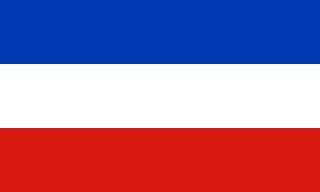
Schleswig-Holstein is the northernmost of the 16 states of Germany, comprising most of the historical duchy of Holstein and the southern part of the former Duchy of Schleswig. Its capital city is Kiel; other notable cities are Lübeck and Flensburg.
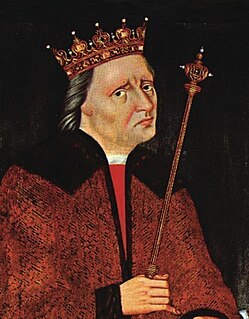
Christian I was a Scandinavian monarch under the Kalmar Union. He was king of Denmark (1448–1481), Norway (1450–1481) and Sweden (1457–1464). From 1460 to 1481, he was also duke of Schleswig and count of Holstein. He was the first king of the House of Oldenburg.
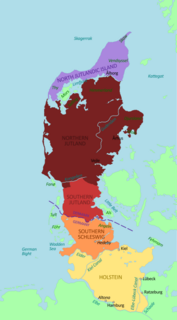
The history of Schleswig-Holstein consists of the corpus of facts since the pre-history times until the modern establishing of the Schleswig-Holstein state.

Selenite, satin spar, desert rose, gypsum flower are crystal habit varieties of the mineral gypsum.

Dolomite (also known as dolomite rock, dolostone or dolomitic rock) is a sedimentary carbonate rock that contains a high percentage of the mineral dolomite, CaMg(CO3)2. It occurs widely, often in association with limestone and evaporites, though it is less abundant than limestone and rare in Cenozoic rock beds (beds less than about 65 million years in age). The first geologist to distinguish dolomite rock from limestone was Belsazar Hacquet in 1778.

The Naica Mine of the Mexican state of Chihuahua, is a lead, zinc and silver mine. Located in Naica in the municipality of Saucillo, the Naica Mine is owned by Industrias Peñoles, the world's largest silver producer. Caverns discovered during mining operations contain gigantic crystals of CaSO
4 · 2 H
2O (calcium sulfate dihydrate, gypsum, also sometimes called selenite. Peñoles announced in October 2015 that it was indefinitely suspending operations due to uncontrollable flooding at the Naica Mine.

The Counts of Schauenburg and Holstein were titles of the Frankish Empire. The dynastic family came from the County of Schauenburg near Rinteln on the Weser in Germany. Together with its ancestral possessions in Bückeburg and Stadthagen, the House of Schauenburg ruled the County of Schauenburg and the County of Holstein. The comital titles of Holstein were subject to the liege lord, the Dukes of undivided Saxony till 1296, and thereafter the Dukes of Saxe-Lauenburg.
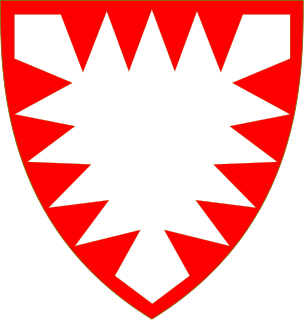
The House of Schaumburg was a dynasty of German rulers. Until c. 1485, it was also known as the House of Schauenburg. Together with its ancestral possession, the County of Schaumburg, the family also ruled the County of Holstein and its partitions Holstein-Itzehoe, Holstein-Kiel, Holstein-Pinneberg, Holstein-Plön, Holstein-Segeberg and Holstein-Rendsburg and through the latter at times also the Duchy of Schleswig.
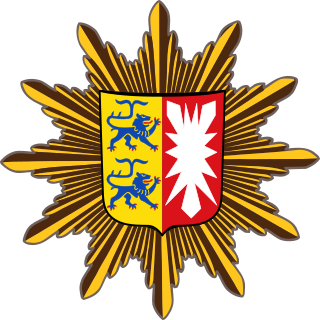
Schleswig-Holstein Police is a state law-enforcement agency in Schleswig-Holstein, Germany. They cover up to the border with Denmark.

The County of Schaumburg, until ca. 1485 known as Schauenburg, was a state of the Holy Roman Empire, located in the present German state of Lower Saxony. Its territory was more or less congruent with the present district Landkreis Schaumburg.

Cave of the Crystals or Giant Crystal Cave is a cave connected to the Naica Mine at a depth of 300 metres (980 ft), in Naica, Chihuahua, Mexico. It takes the form of a chamber within the limestone host rock of the mine, and is about 109-metre (358 ft) long with a volume of 5,000 to 6,000 cubic metres.

The Lüneburg Kalkberg is the cap rock of a salt dome in the western part of the German town of Lüneburg. The Kalkberg was a gypsum mine during the middle ages, but is today a Naturschutzgebiet and a common meeting place for city residents.
John II of Saxe-Lauenburg was the eldest son of John I of Saxony and Ingeborg Birgersdotter of Småland, a daughter or grandchild of Birger jarl. He ruled Saxony jointly with his uncle Albert II and his brothers Albert III and Eric I, first fostered by Albert II, until coming of age. In 1296 John II, his brothers and their uncle divided Saxony into Saxe-Wittenberg, ruled by Albert II, and Saxe-Lauenburg, jointly ruled by the brothers between 1296 and 1303 and thereafter partitioned among them. John II then ruled the branch duchy of Saxe-Mölln, later extended to become Saxe-Bergedorf-Mölln. In 1314 he officiated as Saxon Prince-elector in an election of a German king.

Tourism is an important economic factor for Germany's northernmost state of Schleswig-Holstein.

Gerhard VI was the Count of Holstein-Rendsburg from 1382, and Duke of Schleswig as of 1386.

John II, nicknamed the one-eyed (1253–1321) was the ruling count of Holstein-Kiel from 1263 to 1316.

Adolph V, Count of Holstein-Segeberg was the ruling count of Holstein-Kiel from 1263 to 1273 and of Holstein-Segeberg from 1273 until his death.

The Kalkberg Stadium is an open-air theatre built in a former quarry on the Segeberger Kalkberg, a rocky outcropping in the centre of Bad Segeberg, Schleswig-Holstein, Germany. It was built as a Thingplatz under the Third Reich and since 1952 has been the site of the annual Bad Segeberg Karl May Festival.


















